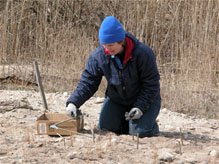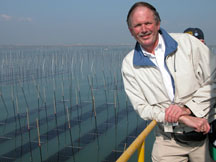Home | Detectives | Suspects | Background Check | Kids' Headquarters | Top Desk Administrator | Case Files
| Who's Who? |
| What's New? |
| Student Stewardship |
| Student Projects |
| Limericks |
| Ask the Experts |
| Meet the Scientists |
Meet the Scientists
Learn what’s going on with the men and women who do invasive species research.
Find out about careers in science that focus on investigating aquatic invaders.
Meet some of the scientists who conduct invasive species research. Their research consists of ways to prevent the spread of established invasive species and how to prevent new species from invading. They will tell you what they do, why they wanted to become a scientist and what is the best part of their job. If you have specific questions for the researchers, go to the “Ask the Expert” section.
 Juliana Barrett, Ph.D., Extension Educator, Coastal Habitats,
Connecticut Sea Grant College Program, University of Connecticut
Juliana Barrett, Ph.D., Extension Educator, Coastal Habitats,
Connecticut Sea Grant College Program, University of Connecticut
How did you get interested in your field?
I love being outside and grew up exploring the fields, woods and streams near where I lived.
My parents were very patient with the many animals, frog eggs and plants I would bring home—even
when the milkweed pods burst open in the warmth of the kitchen and seeds spread everywhere! As I
took different science courses in college, I realized that ecology was the field that really intrigued me.
What do you do?
As an ecologist, I focus on coastal habitats including the management and restoration of coastal habitats
along Long Island Sound (the estuary between the southern border of Connecticut and the northern border of
Long Island, New York)—particularly those in which invasive plants have spread, education of municipal
officials, conservation groups, and homeowners, as well as creating educational materials and web-based
information to help people learn about and better understand these places. Currently I’m working on several
restoration projects including a coastal forest and a dune system—both of which had large invasive plant
populations, and management for a rare plant in a coastal meadow. I will soon be working with several colleagues
on an educational CD about the lower Connecticut River, the largest source of fresh water to Long Island Sound.
What do you like about your job?
Not only do I get to spend time outside conducting research and management activities in interesting habitats,
but also, I get to work and interact with a wide variety of people. There are new questions to ask and always
something new to learn. It is wonderful to help a group with a particular project, and see it come to fruition.
 Charles Yarish, Ph.D.,
Professor, Department of Ecology & Evolutionary Biology, University of Connecticut
Charles Yarish, Ph.D.,
Professor, Department of Ecology & Evolutionary Biology, University of Connecticut
How did you get interested in your field?
I grew up in very close proximity to Jamaica Bay, New York and loved to fish and SCUBA dive along the coast
of New York. Diving at that time was still in its infancy. As an undergraduate student at Brooklyn College,
I was introduced to marine biology by a faculty member who was interested in marine invertebrates and another
interested in the coastal ecology of birds. These faculty members encouraged me to go to a new summer course
at Dalhousie University in between my junior and senior year (1969). The course was an experimental marine
botany course taught by Professor Louie Hanic and the late Professor Peter Dixon. Some of the top marine
botanists (ecologist, physiologist, taxonomists) in the world presented lectures during that 10-week course.
I used my SCUBA skills to learn the macroalgae during that course. I was also introduced to the cultivation
of macroalgae, and from there I was encouraged to go to graduate school to further my study of marine algae.
That particular course and those Brooklyn College faculty members changed my life. Before I knew it, I was a
student at the University of Texas under the supervision of the late Professor Harold Bold and a new faculty
member, Michael J. Wynne. Bold and Wynne provided me with a foundation on cultivation skills that have been
invaluable to my career.
What do you do?
I am involved in the study of macroscopic marine algae (seaweed). I am interested in their ecology, biogeography
and culture. Currently, I am involved in developing integrated multi-trophic aquaculture (IMTA) systems. These
systems combine the culture of fed aquaculture species (finfish) with that of species of shellfish or marine algae
that remove extra nutrients from the water column (organic-bound nutrients are extracted by shellfish such as
oysters and mussels; inorganic nutrients are extracted by the seaweeds). Growing or cultivating all of these
species together is an ecological approach to aquaculture. Closely associated with aquaculture and other human
activities world-wide is the introduction of non-native (invasive species). I am particularly interested in the
study of these opportunistic species and how their introduction may impact native species, as well as affect the
food webs.
What do you like about your job?
The opportunity to explore and find new knowledge is very satisfying. Much of my work involves collaborating
with others, either locally or internationally. For instance, the team that I worked with on IMTA systems
includes scientists from Israel, Canada, Mexico, Chile, Sweden, South Korea, China, and Portugal. The
opportunity to work in these venues, as well as host my colleagues from these countries, gives me a global
view of the world, and an appreciation of their cultures. My students are also able to interact with
colleagues from all over the world—I really enjoy seeing all these cultures working together in my labs at
the University of Connecticut. Currently, I have a student from South Korea finishing his degree, and another
from China just returned to her country. A third doctoral student is from Porto, Portugal whose research takes
him to Portugal, Chile, and my lab in Stamford, Connecticut. I also have two Masters students who are working
on invasive species including the red marine seaweed, Grateloupia turuturu.